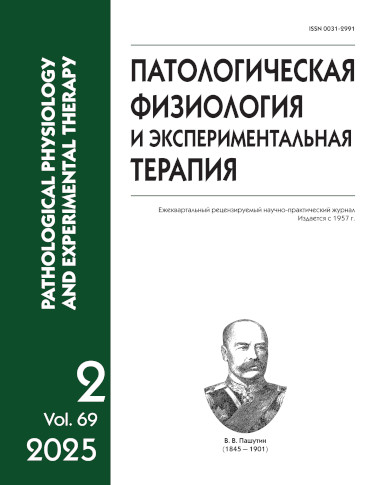Экспериментальное применение модифицированного коллагенового кондуита при замещении дефекта седалищного нерва у крыс
DOI:
https://doi.org/10.48612/pfiet/0031-2991.2025.02.46-53Ключевые слова:
гидрогель, кондуит нерва, внеклеточный матрикс, дефект периферического нерва, регенерацияАннотация
Актуальность. Для разработки и модификации современных конструкций для замещения дефекта нервов используется большое количество различных методик и технологий, одной из которых является получение кондуитов (проводников) на основе биополимеров. При этом для повышения эффективности репарационных процессов в периферическом нерве всё чаще используются различные наполнители, в частности гидрогели на основе внеклеточного матрикса (ВКМ). Цель исследования: оценить репаративный эффект гидрогеля на основе ВКМ в качестве наполнителя коллагенового кондуита нерва в модели повреждения периферического нерва in vivo. Методика. Гидрогель на основе ВКМ получали щелочным гидролизом дермы свиньи. Моделирование дефекта седалищного нерва проводилось на трех группах крыс Wistar: группа 1 (n=5) – контроль, замещение дефекта аутологичным участком седалищного нерва; группа 2 (n=5) – замещение дефекта коллагеновым кондуитом NeuraGen® (Integra, США), заполненным гидрогелем на основе ВКМ; группа 3 (n=5) – замещение дефекта кондуитом NeuraGen® без наполнителя. Оценку репаративного эффекта проводили с помощью иммуногистохимического окрашивания для оценки количества нейрофиламентов и моторных волокон, степени миелинизации проксимального, медиального и дистального фрагментов нервов. Результаты. Иммуногистохимическая оценка имплантированных образцов выявила высокий уровень экспрессии основного белка миелина (MBP), холинацетилтрансферазы (ChAT) и нейрофиламентов (NF) в проксимальном отрезке нерва у животных всех групп. В группе с аутографтом показатели экспрессии исследуемых белков были значимо выше по сравнению с другими группами. Однако в группе 2 были получены более высокие значения экспрессии иммуногистохимических маркеров на всем протяжении восстановленного нерва, чем в группе 3, что демонстрирует положительный эффект модификации нервного кондуита гидрогелем на основе ВКМ. Заключение. Модификация коллагенового кондуита NeuraGen® гидрогелем на основе ВКМ способствовала повышению эффективности регенерации нервной ткани при замещении дефекта периферического нерва. Полученный гидрогель, вероятно, оказывает стимулирующее воздействие на рост нервных волокон, повышает миграцию и пролиферацию шванновских клеток, что обуславливает необходимость дальнейшей разработки и усовершенствования существующих кондуитов нервов.Загрузки
Опубликован
2025-06-20
Выпуск
Раздел
Оригинальные исследования
Как цитировать
[1]
2025. Экспериментальное применение модифицированного коллагенового кондуита при замещении дефекта седалищного нерва у крыс. Патологическая физиология и экспериментальная терапия. 69, 2 (Jun. 2025), 46–53. DOI:https://doi.org/10.48612/pfiet/0031-2991.2025.02.46-53.













